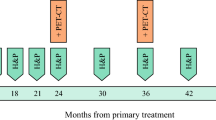Abstract
Purpose
In malignant melanoma, recurrence is often observed in distant areas from the primary site. While FDG PET is a sensitive imaging for detecting malignant lesions, the role of FDG PET in posttreatment surveillance period has not been investigated sufficiently. The aim of this study was to evaluate the value of PET during posttreatment surveillance in melanoma.
Methods
A total of 76 melanoma patients who underwent FDG PET during surveillance period after completion of the first treatment were retrospectively enrolled. PET scans were grouped according to the purpose and clinical situations, routine surveillance, or evaluating clinical suspicion. Final diagnosis of recurrence was determined by complete clinical evaluation or long-term follow-up. In each situation, the diagnostic role of FDG PET was assessed.
Results
A total of 143 scans of 76 patients were analyzed: 51 for clinical suspicion and 92 for routine surveillance. In the clinical suspicion group, PET correctly diagnosed non-recurrence in 10 cases (20%). In routine surveillance group, 16 cases (17%) presented recurrence, all of which was correctly diagnosed on PET. NPV and PPV were 100% and 76%, respectively. In subgroup analysis, sensitivity and NPV were higher in the low-risk group (stages I–IIA) than in the high-risk group (stages IIB–IV), while specificity and PPV were higher in the high-risk group.
Conclusion
In conclusion, FDG PET is an effective diagnostic tool in posttreatment surveillance of melanoma. Even in cases without clinical suspicion, melanoma recurs in a considerable proportion of patients, which can be sensitively diagnosed on PET.





Similar content being viewed by others
References
Nikolaou V, Stratigos AJ. Emerging trends in the epidemiology of melanoma. Br J Dermatol. 2014;170:11–9.
Chen L, Jin S. Trends in mortality rates of cutaneous melanoma in East Asian populations. PeerJ. 2016;4:e2809.
Faries MB, Steen S, Ye X, Sim M. Late recurrence in melanoma: clinical implications of lost dormancy. J Am Coll Surg. 2013;217:27–34.
Romano E, Scordo M, Dusza SW, Coit DG, Chapman PB. Site and timing of first relapse in stage III melanoma patients: implications for follow-up guidelines. J Clin Oncol. 2010;28:3042–7.
Meyers MO, Yeh JJ, Frank J, Long P, Deal AM, Amos KD, et al. Method of detection of initial recurrence of stage II/III cutaneous melanoma: analysis of the utility of follow-up staging. Ann Surg Oncol. 2009;16:941–7.
Bichakjian CK, Halpern AC, Johnson TM, Hood AF, Grichnik JM, Swetter SM, et al. Guidelines of care for the management of primary cutaneous melanoma. J Am Acad Dermatol. 2011;65:1032–47.
Trotter SC, Sroa N, Winkelmann RR, Olencki T, Bechtel M. A global review of melanoma follow-up guidelines. J Clin Aesthet Dermatol. 2013;6:18–26.
Reinhardt MJ, Joe AY, Jaeger U, Huber A, Matthies A, Bucerius J, et al. Diagnostic performance of whole body dual modality 18F-FDG PET/CT imaging for N- and M-staging of malignant melanoma: experience with 250 consecutive patients. J Clin Oncol. 2006;24:1178–87.
Beasley GM, Parsons C, Broadwater G, Selim MA, Marzban S, Abernethy AP, et al. A multicenter prospective evaluation of the clinical utility of F-18 FDG-PET/CT in patients with AJCC stage IIIB or IIIC extremity melanoma. Ann Surg. 2012;256:350–6.
Brown RE, Stromberg AJ, Hagendoorn LJ, Hulsewede DY, Ross MI, Noyes RD, et al. Surveillance after surgical treatment of melanoma: futility of routine chest radiography. Surgery. 2010;148:711–7.
Danielsen M, Hojgaard L, Kjaer A, Fischer BMB, et al. Positron emission tomography in the follow-up of cutaneous malignant melanoma patients: a systematic review. Am J Nucl Med Mol Imaging. 2014;4:17–28.
Hengge UR, Wallerand A, Stutzki A, Kochel N. Cost-effectiveness of reduced follow-up in malignant melanoma. J Dtsch Dermatol Ges. 2007;5:898–907.
Koskivuo IO, Seppanen MP, Suominen EA, Minn HR. Whole body positron emission tomography in follow-up of high risk melanoma. Acta Oncol. 2007;46:685–90.
Morton RL, Craig JC, Thompson JF. The role of surveillance chest X-rays in the follow-up of high-risk melanoma patients. Ann Surg Oncol. 2009;16:571–7.
Taghipour M, Marcus C, Sheikhbahaei S, Mena E, Prasad S, Jha AK, et al. Clinical indications and impact on management: fourth and subsequent posttherapy follow-up 18F-FDG PET/CT scans in oncology patients. J Nucl Med. 2017;58:737–43.
Choi EK, Yoo IR, Park HL, Choi HS, Han EJ, Kim SH, et al. Value of surveillance 18F-FDG PET/CT in colorectal cancer: comparison with conventional imaging studies. Nucl Med Mol Imaging. 2012;46:189–95.
Lewin J, Sayers L, Kee D, Walpole I, Sanelli A, Marvelde LT, et al. Surveillance imaging with FDG-PET/CT in the post-operative follow-up of stage 3 melanoma. Ann Oncol. 2018; https://doi.org/10.1093/annonc/mdy124.
National Comprehensive Cancer Network (NCCN). NCCN guidelines version 2. 2018 Melanoma. https://www.nccn.org/professionals/physician_gls/pdf/melanoma.pdf. Accessed April 11, 2018.
Vensby PH, Schmidt G, Kjær A, Fischer BM. The value of FDG PET/CT for follow-up of patients with melanoma: a retrospective analysis. Am J Nucl Med Mol Imaging. 2017;7:255–62.
Mena E, Taghipour M, Sheikhbahaei S, Mipour S, Xiao J, Shbramaniam RM. 18F-FDG PET/CT and melanoma: value of fourth and subsequent posttherapy follow-up scans for patient management. Clin Nucl Med. 2016;41:e403–9.
Author information
Authors and Affiliations
Corresponding author
Ethics declarations
Conflict of Interest
Hwan Hee Lee, Jin Chul Paeng, Gi Jeong Cheon, Dong Soo Lee, June-Key Chung, and Keon Wook Kang declare that they have no conflict of interest.
Ethical Approval
All procedures performed in studies involving human participants were in accordance with the ethical standards of the institutional and/or national research committee and with the 1964 Helsinki declaration and its later amendments or comparable ethical standards.
Informed Consent
The study design of the retrospective analysis and exemption of informed consent were approved by the Institutional Review Board of the Seoul National University Hospital (H-1804-008-932).
Rights and permissions
About this article
Cite this article
Lee, H.H., Paeng, J.C., Cheon, G.J. et al. Recurrence of Melanoma After Initial Treatment: Diagnostic Performance of FDG PET in Posttreatment Surveillance. Nucl Med Mol Imaging 52, 327–333 (2018). https://doi.org/10.1007/s13139-018-0537-6
Received:
Revised:
Accepted:
Published:
Issue Date:
DOI: https://doi.org/10.1007/s13139-018-0537-6




